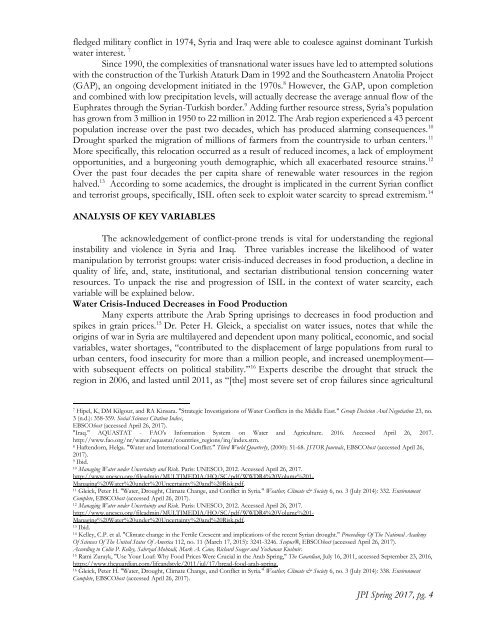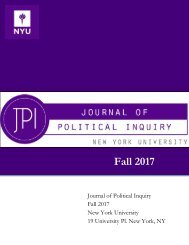SpringIssue_2017
You also want an ePaper? Increase the reach of your titles
YUMPU automatically turns print PDFs into web optimized ePapers that Google loves.
fledged military conflict in 1974, Syria and Iraq were able to coalesce against dominant Turkish<br />
water interest. 7<br />
Since 1990, the complexities of transnational water issues have led to attempted solutions<br />
with the construction of the Turkish Ataturk Dam in 1992 and the Southeastern Anatolia Project<br />
(GAP), an ongoing development initiated in the 1970s. 8 However, the GAP, upon completion<br />
and combined with low precipitation levels, will actually decrease the average annual flow of the<br />
Euphrates through the Syrian-Turkish border. 9 Adding further resource stress, Syria’s population<br />
has grown from 3 million in 1950 to 22 million in 2012. The Arab region experienced a 43 percent<br />
population increase over the past two decades, which has produced alarming consequences. 10<br />
Drought sparked the migration of millions of farmers from the countryside to urban centers. 11<br />
More specifically, this relocation occurred as a result of reduced incomes, a lack of employment<br />
opportunities, and a burgeoning youth demographic, which all exacerbated resource strains. 12<br />
Over the past four decades the per capita share of renewable water resources in the region<br />
halved. 13 According to some academics, the drought is implicated in the current Syrian conflict<br />
and terrorist groups, specifically, ISIL often seek to exploit water scarcity to spread extremism. 14<br />
ANALYSIS OF KEY VARIABLES<br />
The acknowledgement of conflict-prone trends is vital for understanding the regional<br />
instability and violence in Syria and Iraq. Three variables increase the likelihood of water<br />
manipulation by terrorist groups: water crisis-induced decreases in food production, a decline in<br />
quality of life, and, state, institutional, and sectarian distributional tension concerning water<br />
resources. To unpack the rise and progression of ISIL in the context of water scarcity, each<br />
variable will be explained below.<br />
Water Crisis-Induced Decreases in Food Production<br />
Many experts attribute the Arab Spring uprisings to decreases in food production and<br />
spikes in grain prices. 15 Dr. Peter H. Gleick, a specialist on water issues, notes that while the<br />
origins of war in Syria are multilayered and dependent upon many political, economic, and social<br />
variables, water shortages, “contributed to the displacement of large populations from rural to<br />
urban centers, food insecurity for more than a million people, and increased unemployment—<br />
with subsequent effects on political stability.” 16 Experts describe the drought that struck the<br />
region in 2006, and lasted until 2011, as “[the] most severe set of crop failures since agricultural<br />
7<br />
Hipel, K, DM Kilgour, and RA Kinsara. "Strategic Investigations of Water Conflicts in the Middle East." Group Decision And Negotiation 23, no.<br />
3 (n.d.): 358-359. Social Sciences Citation Index,<br />
EBSCOhost (accessed April 26, <strong>2017</strong>).<br />
"Iraq." AQUASTAT - FAO's Information System on Water and Agriculture. 2016. Accessed April 26, <strong>2017</strong>.<br />
http://www.fao.org/nr/water/aquastat/countries_regions/irq/index.stm.<br />
8<br />
Haftendorn, Helga. "Water and International Conflict." Third World Quarterly, (2000): 51-68. JSTOR Journals, EBSCOhost (accessed April 26,<br />
<strong>2017</strong>).<br />
9<br />
Ibid.<br />
10<br />
Managing Water under Uncertainty and Risk. Paris: UNESCO, 2012. Accessed April 26, <strong>2017</strong>.<br />
http://www.unesco.org/fileadmin/MULTIMEDIA/HQ/SC/pdf/WWDR4%20Volume%201-<br />
Managing%20Water%20under%20Uncertainty%20and%20Risk.pdf.<br />
11<br />
Gleick, Peter H. "Water, Drought, Climate Change, and Conflict in Syria." Weather, Climate & Society 6, no. 3 (July 2014): 332. Environment<br />
Complete, EBSCOhost (accessed April 26, <strong>2017</strong>).<br />
12<br />
Managing Water under Uncertainty and Risk. Paris: UNESCO, 2012. Accessed April 26, <strong>2017</strong>.<br />
http://www.unesco.org/fileadmin/MULTIMEDIA/HQ/SC/pdf/WWDR4%20Volume%201-<br />
Managing%20Water%20under%20Uncertainty%20and%20Risk.pdf.<br />
13<br />
Ibid.<br />
14<br />
Kelley, C.P. et al. "Climate change in the Fertile Crescent and implications of the recent Syrian drought." Proceedings Of The National Academy<br />
Of Sciences Of The United States Of America 112, no. 11 (March 17, 2015): 3241-3246. Scopus®, EBSCOhost (accessed April 26, <strong>2017</strong>).<br />
According to Colin P. Kelley, Sahrzad Mohtadi, Mark A. Cane, Richard Seager and Yochanan Kushnir.<br />
15<br />
Rami Zurayk, "Use Your Loaf: Why Food Prices Were Crucial in the Arab Spring," The Guardian, July 16, 2011, accessed September 23, 2016,<br />
https://www.theguardian.com/lifeandstyle/2011/jul/17/bread-food-arab-spring.<br />
16<br />
Gleick, Peter H. "Water, Drought, Climate Change, and Conflict in Syria." Weather, Climate & Society 6, no. 3 (July 2014): 338. Environment<br />
Complete, EBSCOhost (accessed April 26, <strong>2017</strong>).<br />
JPI Spring <strong>2017</strong>, pg. 4
















